What are the benefits of Ceramic bearings versus steel? Why do ceramic bearings cost more? Are hybrid ceramic bearings better than steel bearings? How does ceramic ball bearings compare to stainless steel? Does using ceramic bearings translate to better performance on bicycles or skateboards/ longboards? If you are looking for answers to these questions, read on.
Let us first examine the different types of ceramic bearings:
1. Full Ceramic Bearings (ZrO2) material
– Most commonly used ceramic material. It offers excellent electrical and magnetism resistance, great against wear, corrosion-resistant, lubrication and maintenance-free
– Retainer cage is usually Polytetrafluoroethylene (PTFE) or Polyetheretherketone (PEEK)
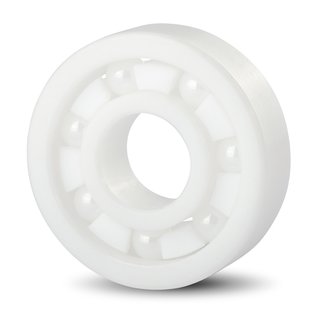
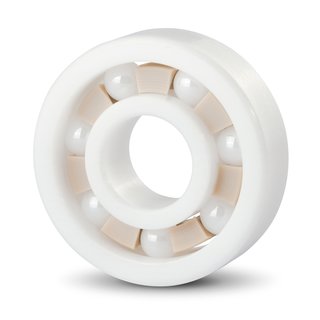
Fig 1: [Left] Ceramic bearing with ZrO2 housing and balls, PTFE cage. [Right] Ceramic bearing with ZrO2 housing and balls, PEEK cage.
2. Full Ceramic Bearings (Si3N4) material
– Compared to ZrO2, Si3N4 ceramic bearings can take higher load and be used in high temperature environments. They also have high speeds.
– Retainer cage is usually PTFE or PEEK.
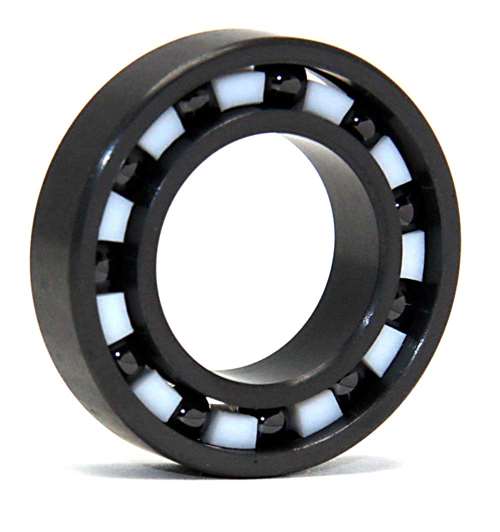 Fig 2: Ceramic bearing with Si3N4 housing and balls, PTFE cage.
Fig 2: Ceramic bearing with Si3N4 housing and balls, PTFE cage.
3. Full Ceramic Bearings with full complement balls
– No cage, so as to add more ceramic balls in the ball bearings, increasing the radial load.
– Lower performance in high speed applications, and therefore should not be used with applications that requires axial load.
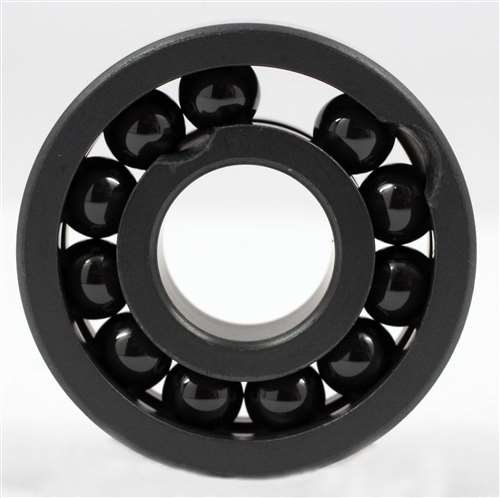 Fig 3: Si3N4 Full complement ceramic bearing.
Fig 3: Si3N4 Full complement ceramic bearing.
4. Full Ceramic Bearings with Ceramic Cage
Performs great against wear, corrosion resistant, high strength, lubrication and maintenance free. Works well in corrosive, low temperature or high vacuum areas.
– Retainer cage is typically ZrO2
5. Hybrid Ceramic Ball Bearings
– In a hybrid construction, the inner ring and outer rings are typically stainless steel (SUS 316 or SUS 304) for creating high speed, high accuracy, and high durability. They are also less expensive than full ceramic bearings.
– Si3N4 Ceramic balls are used to achieve high speeds due to its low density and low friction coefficient. They are also electrical and magnetism resistant, wear resistant, maintenance and lubrication free, and highly rigid. This makes it the best choice for rollers.
– Retainer cage can be PTFE, peek or full complement.
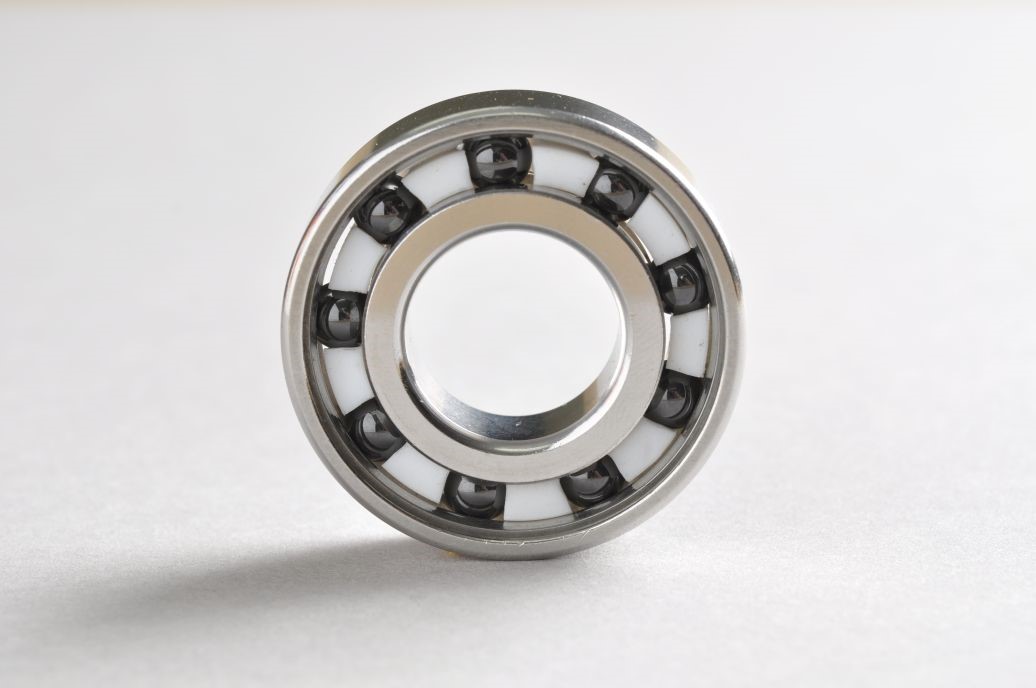 Fig 4: Hybrid Ceramic bearing with stainless steel housing with Si3N4 balls & PFTE cage.
Fig 4: Hybrid Ceramic bearing with stainless steel housing with Si3N4 balls & PFTE cage.
Ceramic Properties Comparison Table
| Inner & Outer Rings/Ball/Cage | Load Capacity | Speed | Corrosion Resistance | Max. Working Temperature | Price |
| ZrO2/ ZrO2/PTFE | ? ? ? | ? ? ? ? | ? ? ? ? ? | 180 °C | $$$$ |
| ZrO2/ ZrO2/PEEK | ? ? ? | ? ? ? ? | ? ? ? ? | 260 °C | $$$$ |
| ZrO2/ ZrO2/No Cage | ? ? ? | ? ? ? | ? ? ? ? ? | 400 °C | $$$$ |
| Si3N4/Si3N4/PTFE | ? ? ? ? | ? ? ? ? ? | ? ? ? ? ? | 180 °C | $$$$$ |
| Si3N4/Si3N4/PEEK | ? ? ? ? | ? ? ? ? ? | ? ? ? ? | 260 °C | $$$$$ |
| Si3N4/Si3N4/No Cage | ? ? ? ? | ? ? ? ? | ? ? ? ? ? | 1100 °C | $$$$$ |
| 440C/ZrO2/304 | ? ? ? ? | ? ? ? ? ? | ? | 180 °C | $ |
| 440C/Si3N4/304 | ? ? ? ? ? | ? ? ? ? ? | ? | 180 °C | $$ |
| 316/ ZrO2/PTFE | ? ? | ? ? ? | ? ? | 180 °C | $$ |
| 316/ Si3N4/316 | ? ? | ? ? ? | ? ? | 180 °C | $$$ |
Extra notes:
– PTFE and PEEK are types of engineered plastic materials. PEEK is a harder polymer that can withstand high temperatures.
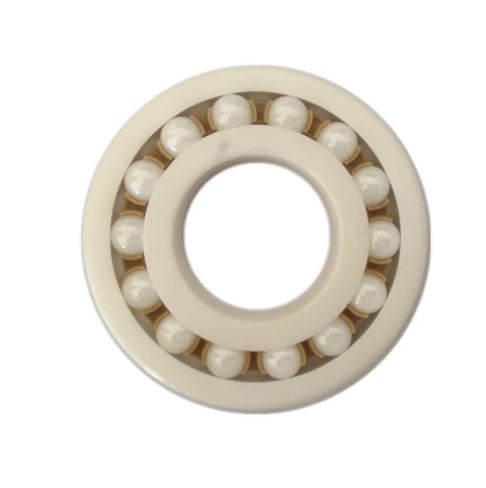 Fig 5: Full PEEK bearing
Fig 5: Full PEEK bearing
– ZrO2 and Si3N4 are types of engineered ceramic materials. Si3N4 is lighter and has better rigidity.
– SUS440C is the most commonly used stainless steel material in making stainless steel ball bearings. If you are looking for a balance between the highest strength and hardness stainless steel bearings, then this is a great choice. SUS440C has good hardness, and hence high durability, and also corrosion resistance. This material can be used with ceramic ZrO2 or Si3N4 to form a hybrid ceramic bearing that can take high speed and heavier loads- a value-for-money pairing.
– SUS 304 and 316 are top-quality stainless steel materials with higher corrosion resistance, but lower strength and hardness. They can also be used with ceramic Si3N4 to form a hybrid ceramic bearing that gives great corrosion resistance, which also costs lesser than full ceramic bearings.
Conclusion
Sports like cycling, skateboarding and roller skating are becoming increasingly popular these days, which also heightens the demand for maintenance parts like bicycle bearings, miniature bearings, and ceramic bearings. As we have seen above, there are significant benefits to using ceramic bearings. Compared to steel bearings, ceramic bearings are lighter, faster, and more corrosion resistant. This translates to lesser maintenance needed, and of course, speed and durability. It is no wonder that outdoor enthusiasts are opting for these ceramic bearings for their skateboards and roller skates wheels. Yes, the benefits do come with a higher price tag, especially when the top-quality ceramic types are chosen, such as the Si3N4 or PEEK. If you have a tighter budget, you could also consider hybrid ceramic bearings for a lower cost alternative.